Tutor Marked Exercise 3: Theory Section - Statistics and Probability
VerifiedAdded on 2022/12/09
|15
|1152
|381
Homework Assignment
AI Summary
This document presents the solutions to the Theory Section of Tutor Marked Exercise 3. The assignment covers various statistical concepts, including regression analysis, hypothesis testing, and correlation. Question 1 explores regression equations, correlation significance, and hypothesis testing. Question 2 delves into regression analysis, calculating the regression equation, interpreting coefficients, and testing the slope and correlation. Question 3 focuses on the F-test, goodness of fit, and the interpretation of R-squared. Finally, Question 4 discusses the calibration problem in regression analysis, specifically inverse regression and its application in dimension reduction techniques. The solutions demonstrate the application of statistical methods to real-world scenarios, referencing relevant statistical literature.
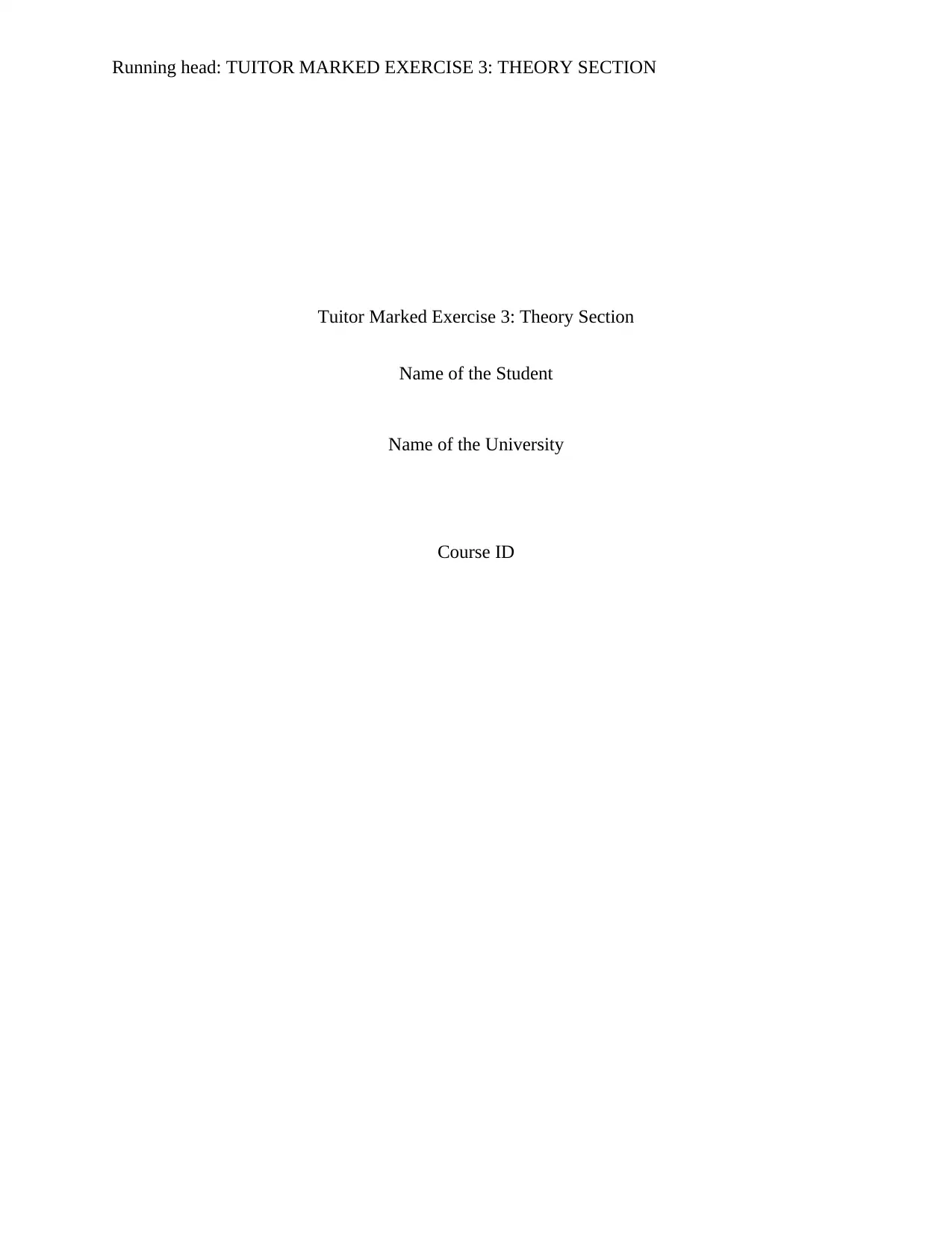
Running head: TUITOR MARKED EXERCISE 3: THEORY SECTION
Tuitor Marked Exercise 3: Theory Section
Name of the Student
Name of the University
Course ID
Tuitor Marked Exercise 3: Theory Section
Name of the Student
Name of the University
Course ID
Paraphrase This Document
Need a fresh take? Get an instant paraphrase of this document with our AI Paraphraser
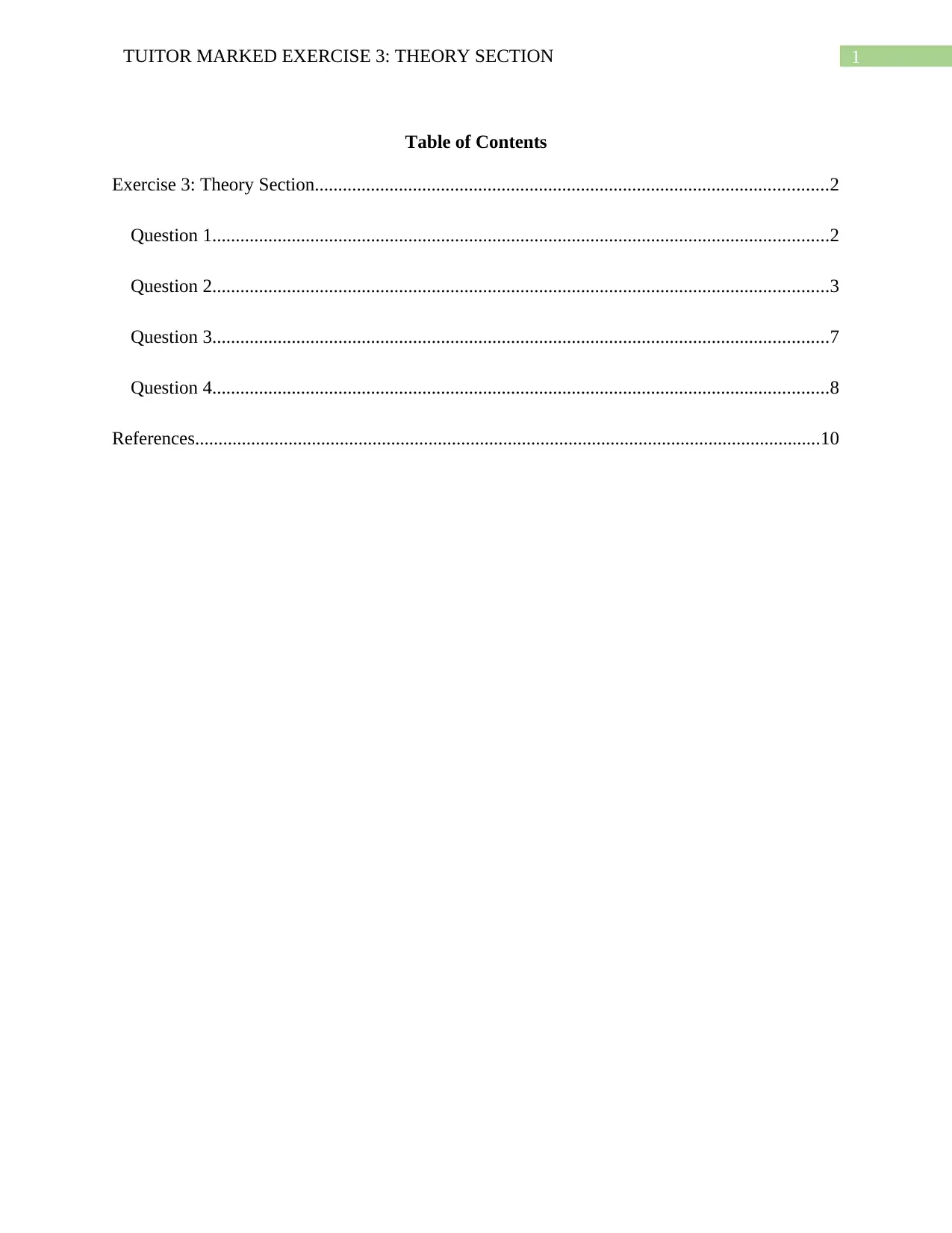
1TUITOR MARKED EXERCISE 3: THEORY SECTION
Table of Contents
Exercise 3: Theory Section..............................................................................................................2
Question 1....................................................................................................................................2
Question 2....................................................................................................................................3
Question 3....................................................................................................................................7
Question 4....................................................................................................................................8
References......................................................................................................................................10
Table of Contents
Exercise 3: Theory Section..............................................................................................................2
Question 1....................................................................................................................................2
Question 2....................................................................................................................................3
Question 3....................................................................................................................................7
Question 4....................................................................................................................................8
References......................................................................................................................................10
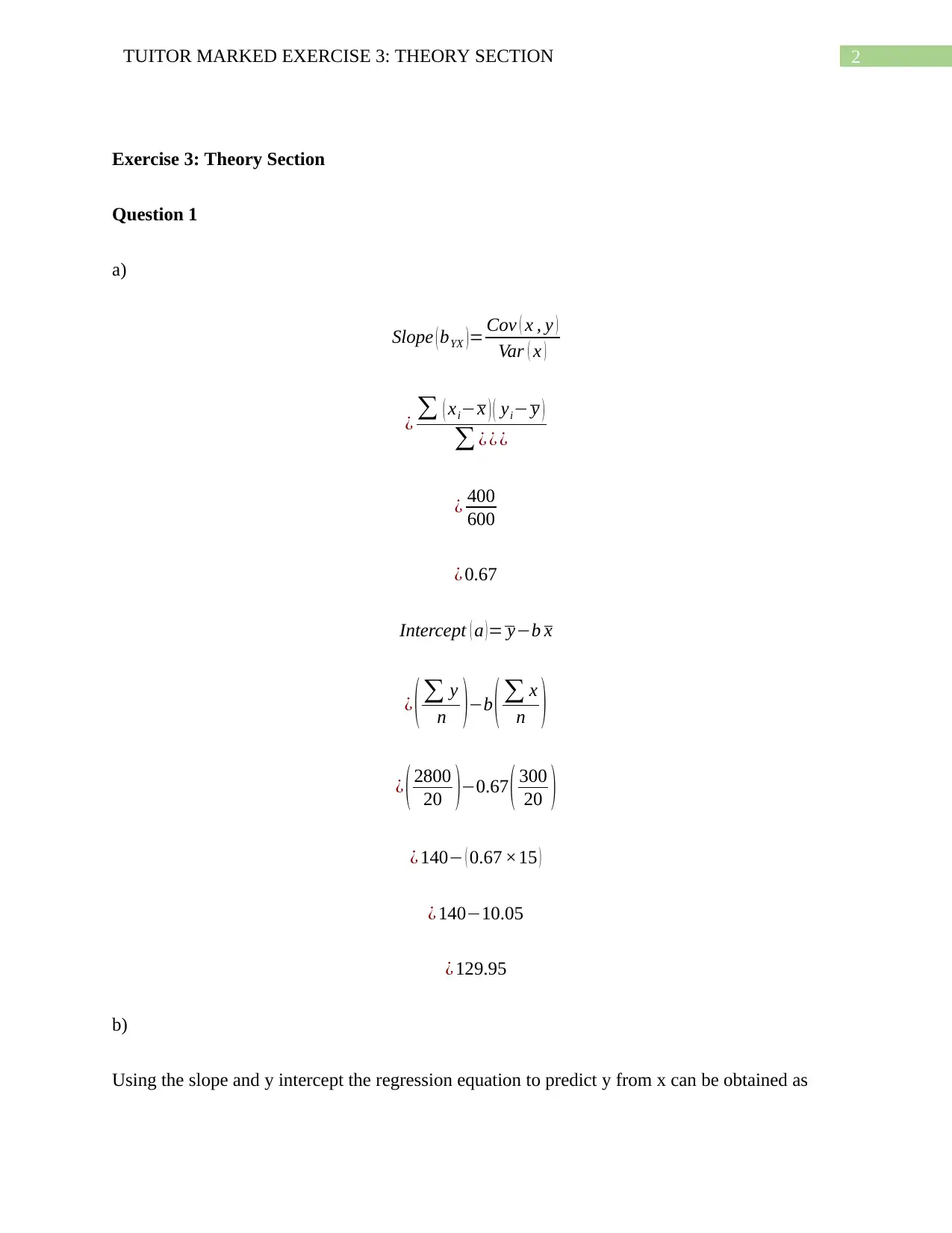
2TUITOR MARKED EXERCISE 3: THEORY SECTION
Exercise 3: Theory Section
Question 1
a)
Slope ( bYX )= Cov ( x , y )
Var ( x )
¿ ∑ ( xi−x )( yi− y )
∑ ¿ ¿ ¿
¿ 400
600
¿ 0.67
Intercept ( a )= y−b x
¿ ( ∑ y
n )−b ( ∑ x
n )
¿ ( 2800
20 )−0.67 ( 300
20 )
¿ 140− ( 0.67 ×15 )
¿ 140−10.05
¿ 129.95
b)
Using the slope and y intercept the regression equation to predict y from x can be obtained as
Exercise 3: Theory Section
Question 1
a)
Slope ( bYX )= Cov ( x , y )
Var ( x )
¿ ∑ ( xi−x )( yi− y )
∑ ¿ ¿ ¿
¿ 400
600
¿ 0.67
Intercept ( a )= y−b x
¿ ( ∑ y
n )−b ( ∑ x
n )
¿ ( 2800
20 )−0.67 ( 300
20 )
¿ 140− ( 0.67 ×15 )
¿ 140−10.05
¿ 129.95
b)
Using the slope and y intercept the regression equation to predict y from x can be obtained as
⊘ This is a preview!⊘
Do you want full access?
Subscribe today to unlock all pages.

Trusted by 1+ million students worldwide
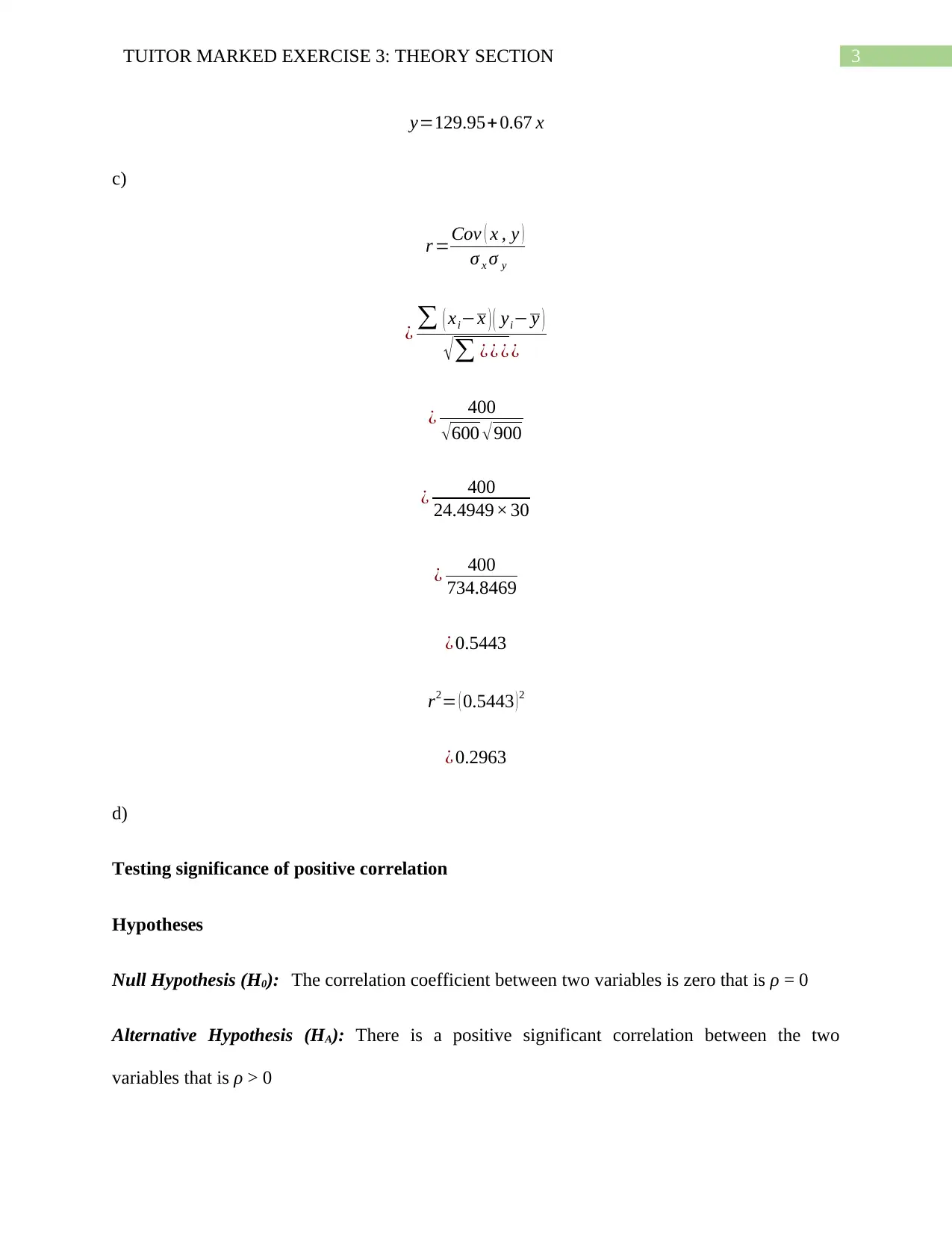
3TUITOR MARKED EXERCISE 3: THEORY SECTION
y=129.95+ 0.67 x
c)
r =Cov ( x , y )
σ x σ y
¿ ∑ ( xi−x )( yi− y )
√ ∑ ¿ ¿ ¿ ¿
¿ 400
√ 600 √ 900
¿ 400
24.4949× 30
¿ 400
734.8469
¿ 0.5443
r2= ( 0.5443 )2
¿ 0.2963
d)
Testing significance of positive correlation
Hypotheses
Null Hypothesis (H0): The correlation coefficient between two variables is zero that is ρ = 0
Alternative Hypothesis (HA): There is a positive significant correlation between the two
variables that is ρ > 0
y=129.95+ 0.67 x
c)
r =Cov ( x , y )
σ x σ y
¿ ∑ ( xi−x )( yi− y )
√ ∑ ¿ ¿ ¿ ¿
¿ 400
√ 600 √ 900
¿ 400
24.4949× 30
¿ 400
734.8469
¿ 0.5443
r2= ( 0.5443 )2
¿ 0.2963
d)
Testing significance of positive correlation
Hypotheses
Null Hypothesis (H0): The correlation coefficient between two variables is zero that is ρ = 0
Alternative Hypothesis (HA): There is a positive significant correlation between the two
variables that is ρ > 0
Paraphrase This Document
Need a fresh take? Get an instant paraphrase of this document with our AI Paraphraser
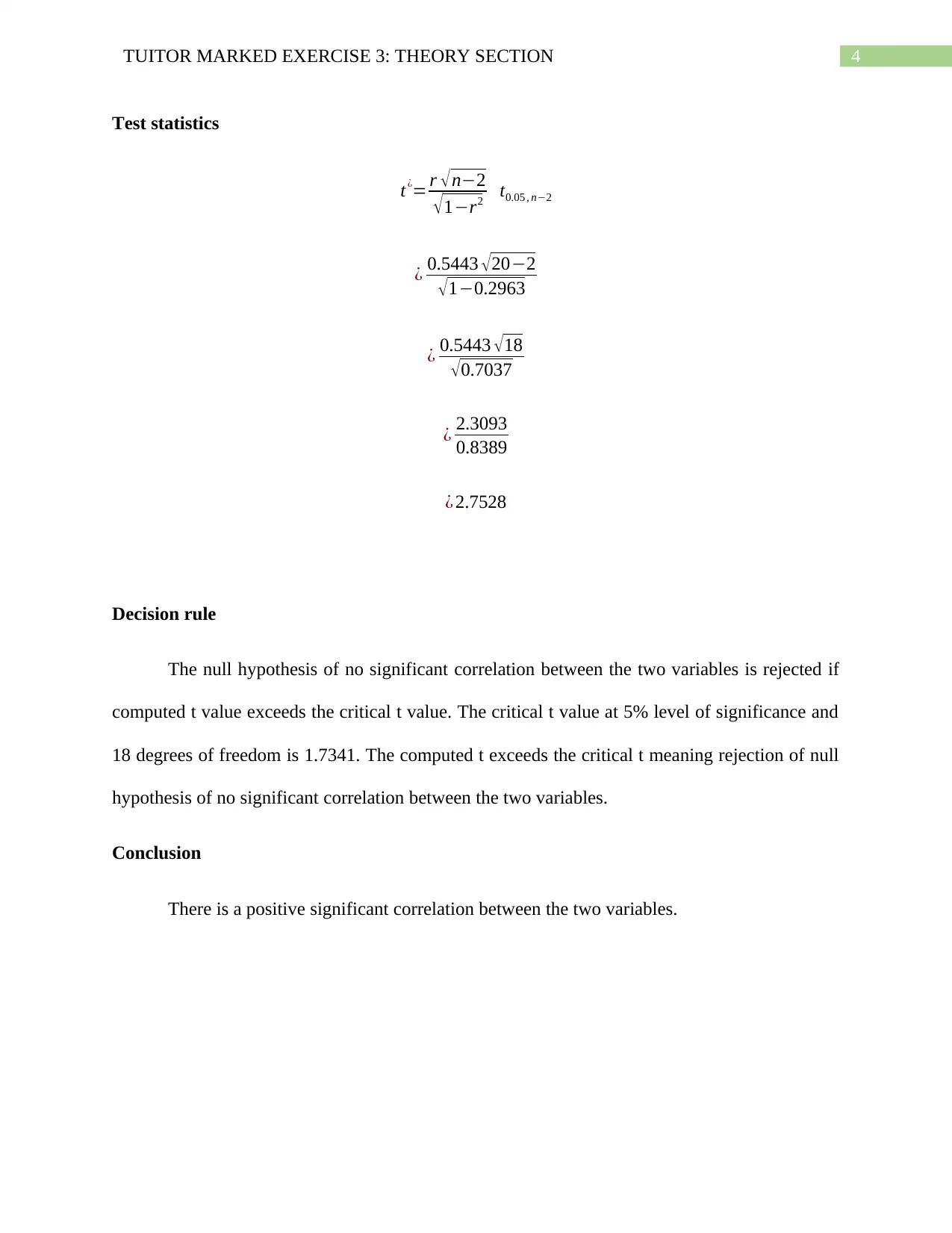
4TUITOR MARKED EXERCISE 3: THEORY SECTION
Test statistics
t¿= r √n−2
√1−r2 t0.05 , n−2
¿ 0.5443 √ 20−2
√ 1−0.2963
¿ 0.5443 √18
√0.7037
¿ 2.3093
0.8389
¿ 2.7528
Decision rule
The null hypothesis of no significant correlation between the two variables is rejected if
computed t value exceeds the critical t value. The critical t value at 5% level of significance and
18 degrees of freedom is 1.7341. The computed t exceeds the critical t meaning rejection of null
hypothesis of no significant correlation between the two variables.
Conclusion
There is a positive significant correlation between the two variables.
Test statistics
t¿= r √n−2
√1−r2 t0.05 , n−2
¿ 0.5443 √ 20−2
√ 1−0.2963
¿ 0.5443 √18
√0.7037
¿ 2.3093
0.8389
¿ 2.7528
Decision rule
The null hypothesis of no significant correlation between the two variables is rejected if
computed t value exceeds the critical t value. The critical t value at 5% level of significance and
18 degrees of freedom is 1.7341. The computed t exceeds the critical t meaning rejection of null
hypothesis of no significant correlation between the two variables.
Conclusion
There is a positive significant correlation between the two variables.
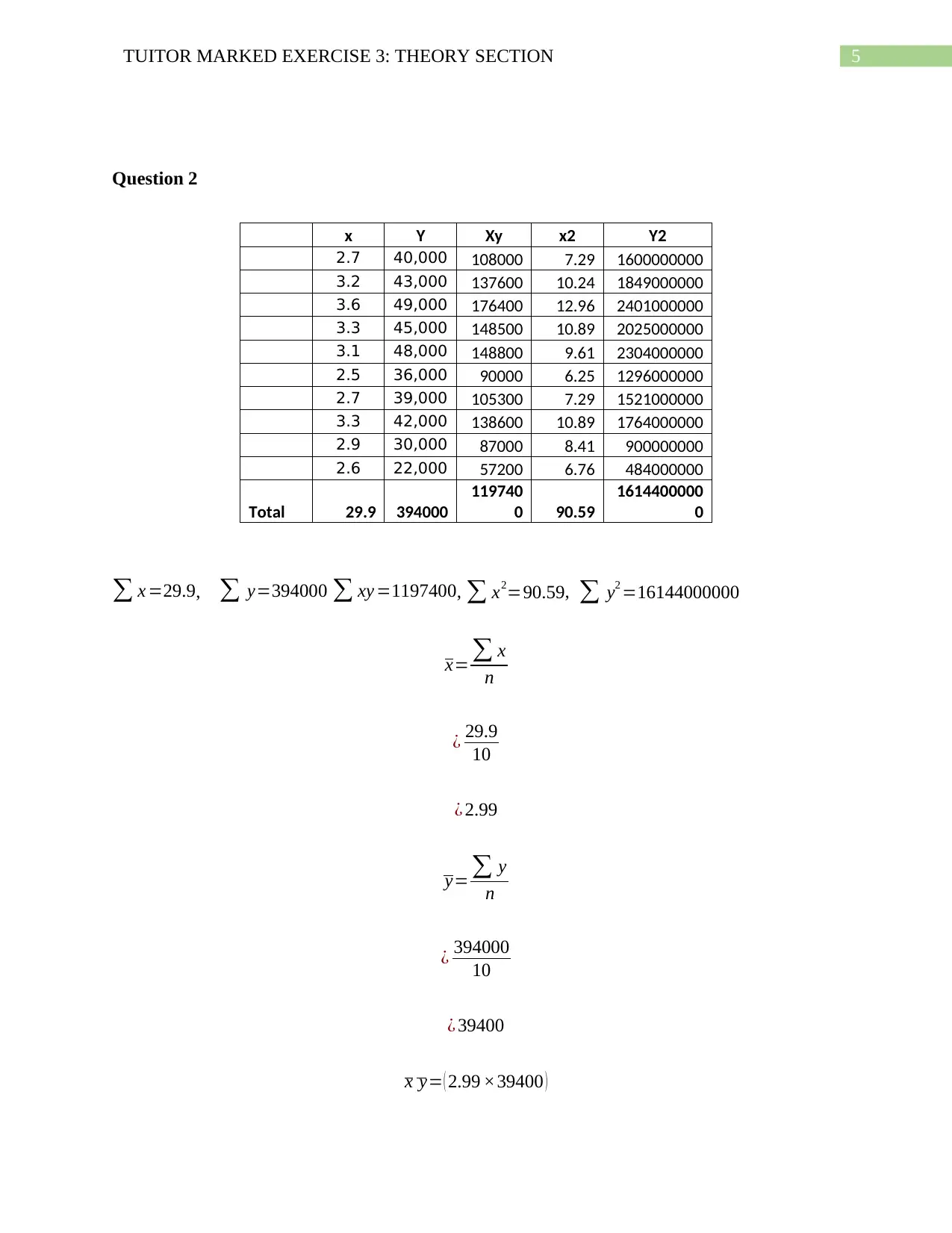
5TUITOR MARKED EXERCISE 3: THEORY SECTION
Question 2
x Y Xy x2 Y2
2.7 40,000 108000 7.29 1600000000
3.2 43,000 137600 10.24 1849000000
3.6 49,000 176400 12.96 2401000000
3.3 45,000 148500 10.89 2025000000
3.1 48,000 148800 9.61 2304000000
2.5 36,000 90000 6.25 1296000000
2.7 39,000 105300 7.29 1521000000
3.3 42,000 138600 10.89 1764000000
2.9 30,000 87000 8.41 900000000
2.6 22,000 57200 6.76 484000000
Total 29.9 394000
119740
0 90.59
1614400000
0
∑ x =29.9, ∑ y=394000 ∑ xy =1197400, ∑ x2=90.59, ∑ y2 =16144000000
x= ∑ x
n
¿ 29.9
10
¿ 2.99
y= ∑ y
n
¿ 394000
10
¿ 39400
x y= ( 2.99 ×39400 )
Question 2
x Y Xy x2 Y2
2.7 40,000 108000 7.29 1600000000
3.2 43,000 137600 10.24 1849000000
3.6 49,000 176400 12.96 2401000000
3.3 45,000 148500 10.89 2025000000
3.1 48,000 148800 9.61 2304000000
2.5 36,000 90000 6.25 1296000000
2.7 39,000 105300 7.29 1521000000
3.3 42,000 138600 10.89 1764000000
2.9 30,000 87000 8.41 900000000
2.6 22,000 57200 6.76 484000000
Total 29.9 394000
119740
0 90.59
1614400000
0
∑ x =29.9, ∑ y=394000 ∑ xy =1197400, ∑ x2=90.59, ∑ y2 =16144000000
x= ∑ x
n
¿ 29.9
10
¿ 2.99
y= ∑ y
n
¿ 394000
10
¿ 39400
x y= ( 2.99 ×39400 )
⊘ This is a preview!⊘
Do you want full access?
Subscribe today to unlock all pages.

Trusted by 1+ million students worldwide
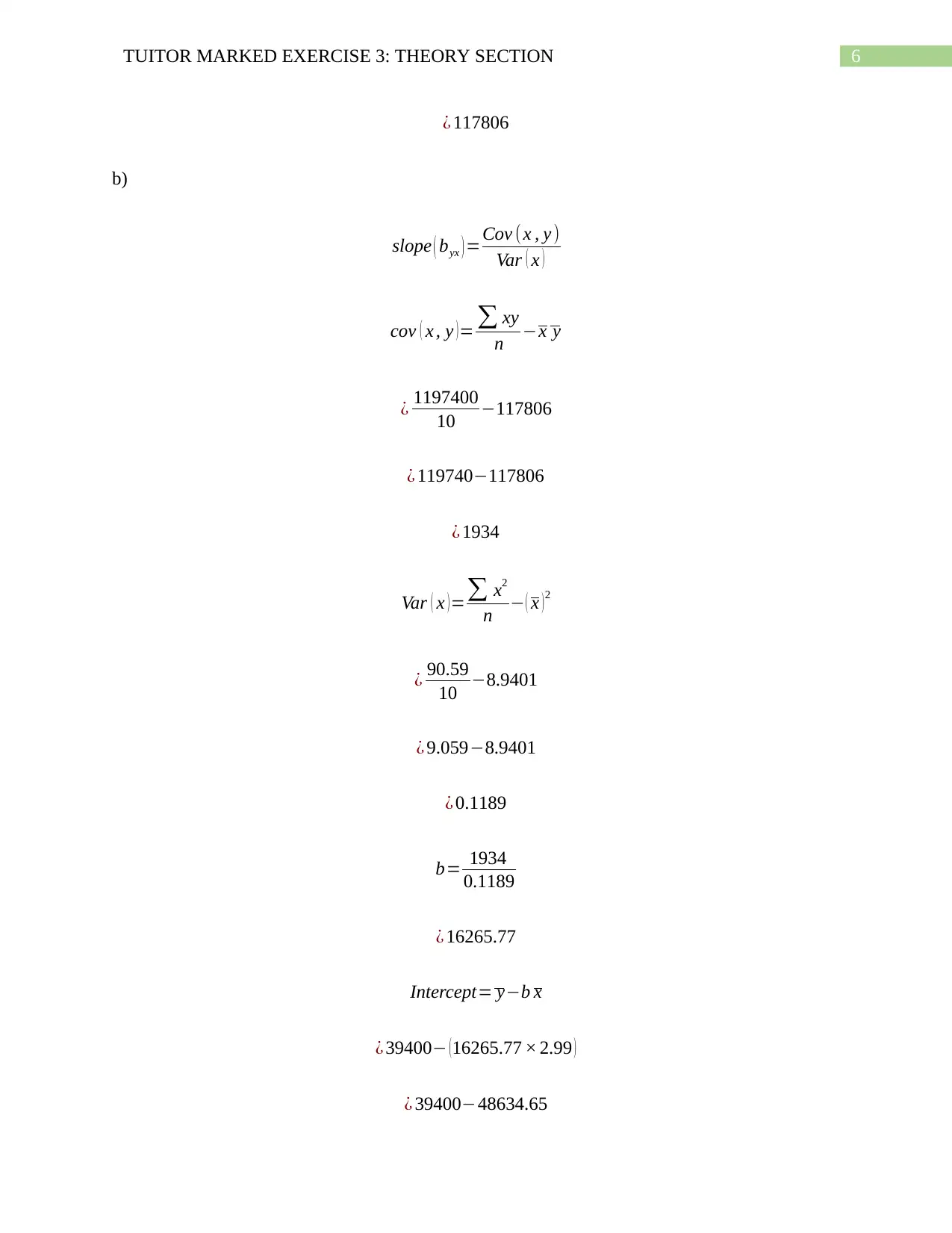
6TUITOR MARKED EXERCISE 3: THEORY SECTION
¿ 117806
b)
slope ( byx ) =Cov (x , y )
Var ( x )
cov ( x , y ) = ∑ xy
n −x y
¿ 1197400
10 −117806
¿ 119740−117806
¿ 1934
Var ( x )=∑ x2
n − ( x )2
¿ 90.59
10 −8.9401
¿ 9.059−8.9401
¿ 0.1189
b= 1934
0.1189
¿ 16265.77
Intercept= y−b x
¿ 39400− (16265.77 × 2.99 )
¿ 39400−48634.65
¿ 117806
b)
slope ( byx ) =Cov (x , y )
Var ( x )
cov ( x , y ) = ∑ xy
n −x y
¿ 1197400
10 −117806
¿ 119740−117806
¿ 1934
Var ( x )=∑ x2
n − ( x )2
¿ 90.59
10 −8.9401
¿ 9.059−8.9401
¿ 0.1189
b= 1934
0.1189
¿ 16265.77
Intercept= y−b x
¿ 39400− (16265.77 × 2.99 )
¿ 39400−48634.65
Paraphrase This Document
Need a fresh take? Get an instant paraphrase of this document with our AI Paraphraser
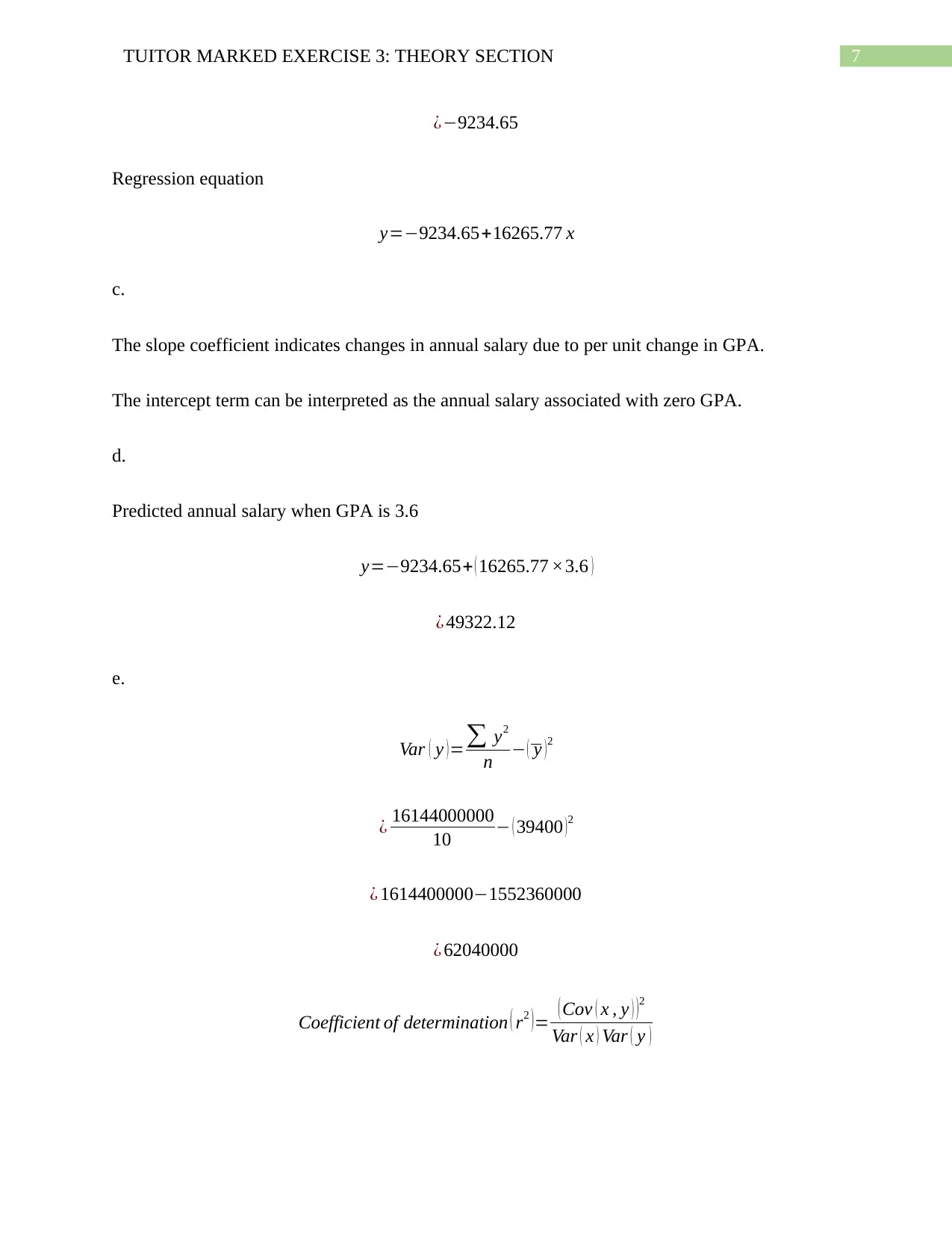
7TUITOR MARKED EXERCISE 3: THEORY SECTION
¿−9234.65
Regression equation
y=−9234.65+16265.77 x
c.
The slope coefficient indicates changes in annual salary due to per unit change in GPA.
The intercept term can be interpreted as the annual salary associated with zero GPA.
d.
Predicted annual salary when GPA is 3.6
y=−9234.65+ ( 16265.77 ×3.6 )
¿ 49322.12
e.
Var ( y )=∑ y2
n − ( y )2
¿ 16144000000
10 − ( 39400 )2
¿ 1614400000−1552360000
¿ 62040000
Coefficient of determination ( r2 )= ( Cov ( x , y ) )2
Var ( x ) Var ( y )
¿−9234.65
Regression equation
y=−9234.65+16265.77 x
c.
The slope coefficient indicates changes in annual salary due to per unit change in GPA.
The intercept term can be interpreted as the annual salary associated with zero GPA.
d.
Predicted annual salary when GPA is 3.6
y=−9234.65+ ( 16265.77 ×3.6 )
¿ 49322.12
e.
Var ( y )=∑ y2
n − ( y )2
¿ 16144000000
10 − ( 39400 )2
¿ 1614400000−1552360000
¿ 62040000
Coefficient of determination ( r2 )= ( Cov ( x , y ) )2
Var ( x ) Var ( y )
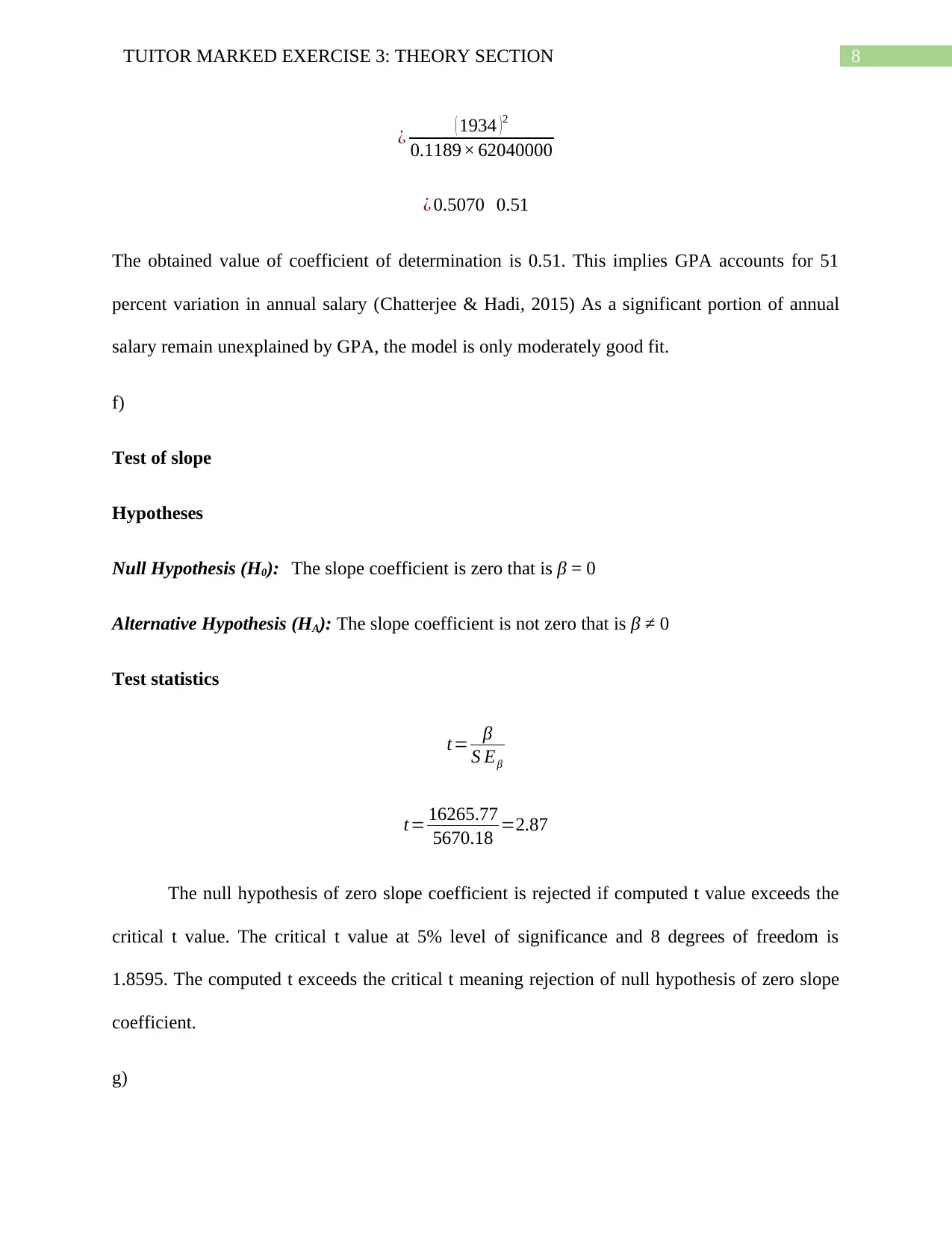
8TUITOR MARKED EXERCISE 3: THEORY SECTION
¿ ( 1934 )2
0.1189× 62040000
¿ 0.5070 0.51
The obtained value of coefficient of determination is 0.51. This implies GPA accounts for 51
percent variation in annual salary (Chatterjee & Hadi, 2015) As a significant portion of annual
salary remain unexplained by GPA, the model is only moderately good fit.
f)
Test of slope
Hypotheses
Null Hypothesis (H0): The slope coefficient is zero that is β = 0
Alternative Hypothesis (HA): The slope coefficient is not zero that is β ≠ 0
Test statistics
t= β
S Eβ
t= 16265.77
5670.18 =2.87
The null hypothesis of zero slope coefficient is rejected if computed t value exceeds the
critical t value. The critical t value at 5% level of significance and 8 degrees of freedom is
1.8595. The computed t exceeds the critical t meaning rejection of null hypothesis of zero slope
coefficient.
g)
¿ ( 1934 )2
0.1189× 62040000
¿ 0.5070 0.51
The obtained value of coefficient of determination is 0.51. This implies GPA accounts for 51
percent variation in annual salary (Chatterjee & Hadi, 2015) As a significant portion of annual
salary remain unexplained by GPA, the model is only moderately good fit.
f)
Test of slope
Hypotheses
Null Hypothesis (H0): The slope coefficient is zero that is β = 0
Alternative Hypothesis (HA): The slope coefficient is not zero that is β ≠ 0
Test statistics
t= β
S Eβ
t= 16265.77
5670.18 =2.87
The null hypothesis of zero slope coefficient is rejected if computed t value exceeds the
critical t value. The critical t value at 5% level of significance and 8 degrees of freedom is
1.8595. The computed t exceeds the critical t meaning rejection of null hypothesis of zero slope
coefficient.
g)
⊘ This is a preview!⊘
Do you want full access?
Subscribe today to unlock all pages.

Trusted by 1+ million students worldwide
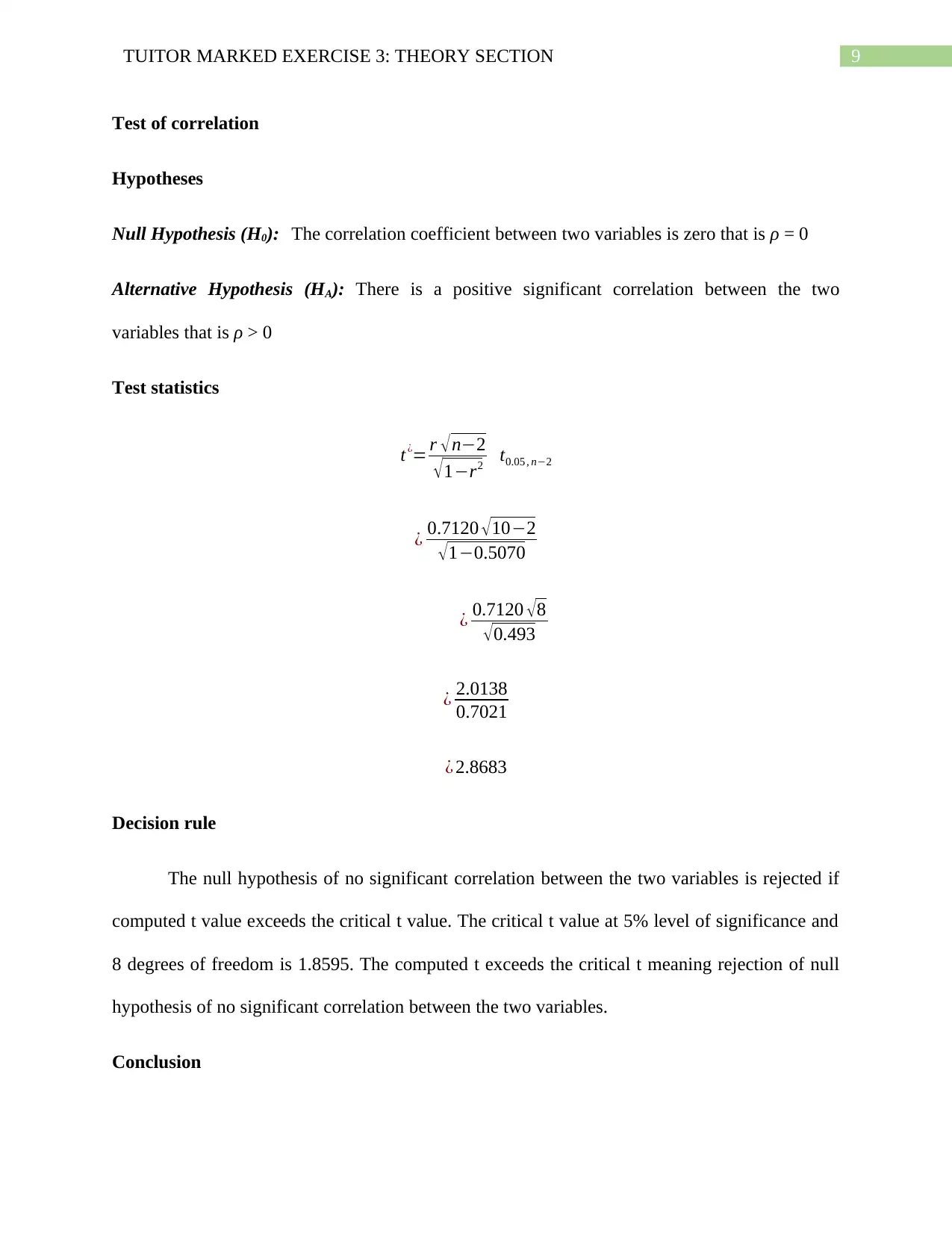
9TUITOR MARKED EXERCISE 3: THEORY SECTION
Test of correlation
Hypotheses
Null Hypothesis (H0): The correlation coefficient between two variables is zero that is ρ = 0
Alternative Hypothesis (HA): There is a positive significant correlation between the two
variables that is ρ > 0
Test statistics
t¿= r √n−2
√1−r2 t0.05 , n−2
¿ 0.7120 √ 10−2
√ 1−0.5070
¿ 0.7120 √8
√0.493
¿ 2.0138
0.7021
¿ 2.8683
Decision rule
The null hypothesis of no significant correlation between the two variables is rejected if
computed t value exceeds the critical t value. The critical t value at 5% level of significance and
8 degrees of freedom is 1.8595. The computed t exceeds the critical t meaning rejection of null
hypothesis of no significant correlation between the two variables.
Conclusion
Test of correlation
Hypotheses
Null Hypothesis (H0): The correlation coefficient between two variables is zero that is ρ = 0
Alternative Hypothesis (HA): There is a positive significant correlation between the two
variables that is ρ > 0
Test statistics
t¿= r √n−2
√1−r2 t0.05 , n−2
¿ 0.7120 √ 10−2
√ 1−0.5070
¿ 0.7120 √8
√0.493
¿ 2.0138
0.7021
¿ 2.8683
Decision rule
The null hypothesis of no significant correlation between the two variables is rejected if
computed t value exceeds the critical t value. The critical t value at 5% level of significance and
8 degrees of freedom is 1.8595. The computed t exceeds the critical t meaning rejection of null
hypothesis of no significant correlation between the two variables.
Conclusion
Paraphrase This Document
Need a fresh take? Get an instant paraphrase of this document with our AI Paraphraser
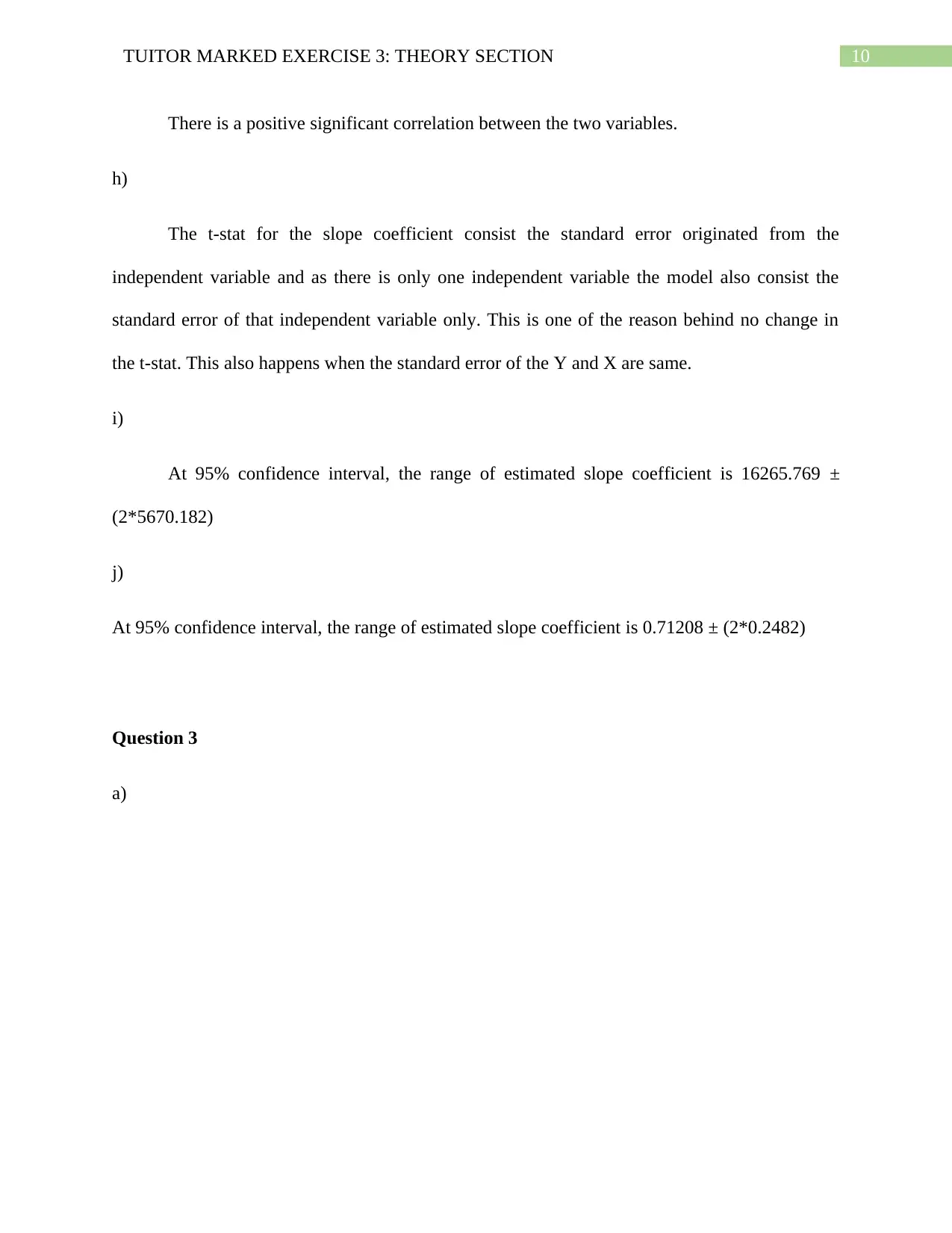
10TUITOR MARKED EXERCISE 3: THEORY SECTION
There is a positive significant correlation between the two variables.
h)
The t-stat for the slope coefficient consist the standard error originated from the
independent variable and as there is only one independent variable the model also consist the
standard error of that independent variable only. This is one of the reason behind no change in
the t-stat. This also happens when the standard error of the Y and X are same.
i)
At 95% confidence interval, the range of estimated slope coefficient is 16265.769 ±
(2*5670.182)
j)
At 95% confidence interval, the range of estimated slope coefficient is 0.71208 ± (2*0.2482)
Question 3
a)
There is a positive significant correlation between the two variables.
h)
The t-stat for the slope coefficient consist the standard error originated from the
independent variable and as there is only one independent variable the model also consist the
standard error of that independent variable only. This is one of the reason behind no change in
the t-stat. This also happens when the standard error of the Y and X are same.
i)
At 95% confidence interval, the range of estimated slope coefficient is 16265.769 ±
(2*5670.182)
j)
At 95% confidence interval, the range of estimated slope coefficient is 0.71208 ± (2*0.2482)
Question 3
a)
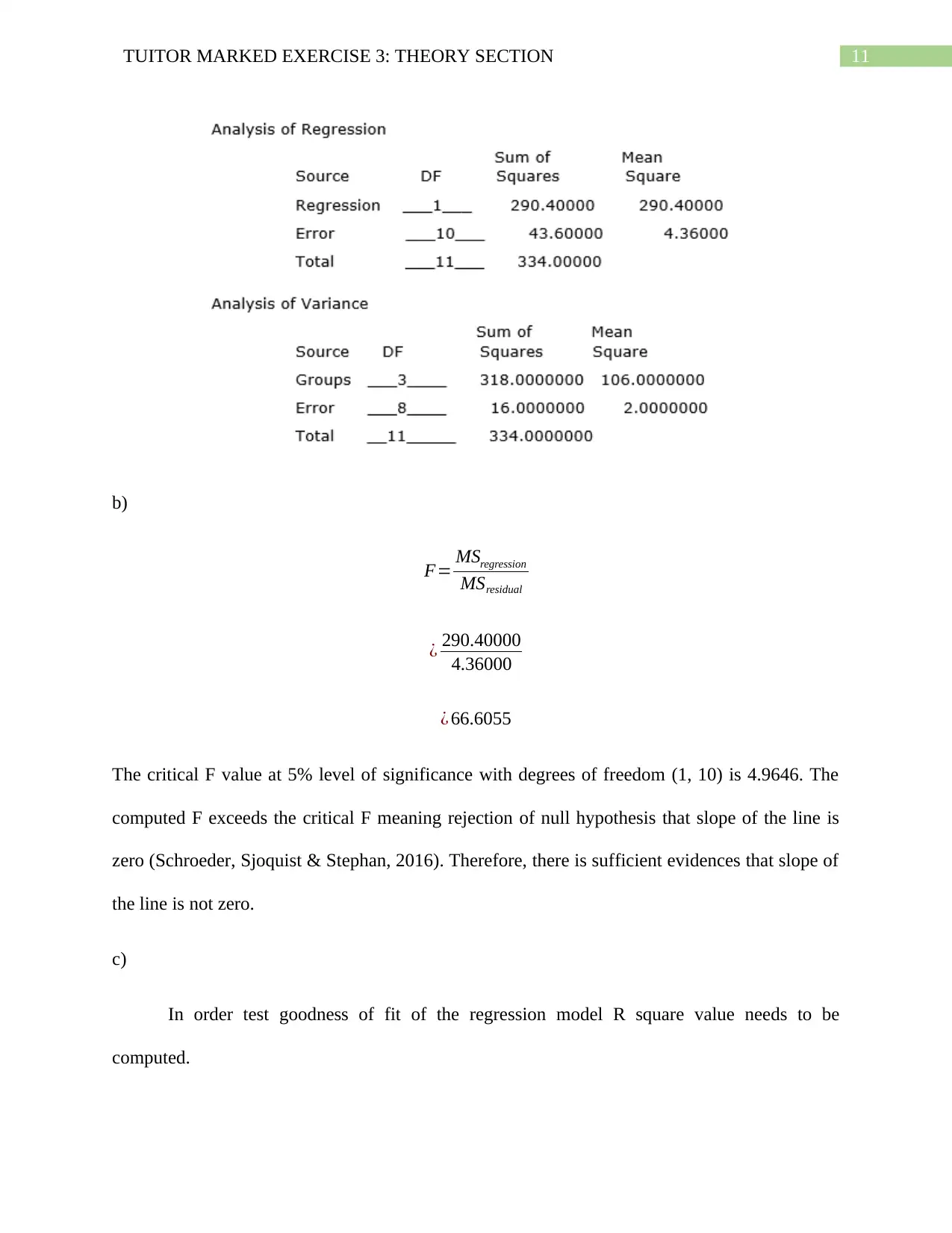
11TUITOR MARKED EXERCISE 3: THEORY SECTION
b)
F= MSregression
MSresidual
¿ 290.40000
4.36000
¿ 66.6055
The critical F value at 5% level of significance with degrees of freedom (1, 10) is 4.9646. The
computed F exceeds the critical F meaning rejection of null hypothesis that slope of the line is
zero (Schroeder, Sjoquist & Stephan, 2016). Therefore, there is sufficient evidences that slope of
the line is not zero.
c)
In order test goodness of fit of the regression model R square value needs to be
computed.
b)
F= MSregression
MSresidual
¿ 290.40000
4.36000
¿ 66.6055
The critical F value at 5% level of significance with degrees of freedom (1, 10) is 4.9646. The
computed F exceeds the critical F meaning rejection of null hypothesis that slope of the line is
zero (Schroeder, Sjoquist & Stephan, 2016). Therefore, there is sufficient evidences that slope of
the line is not zero.
c)
In order test goodness of fit of the regression model R square value needs to be
computed.
⊘ This is a preview!⊘
Do you want full access?
Subscribe today to unlock all pages.

Trusted by 1+ million students worldwide
1 out of 15
Related Documents
Your All-in-One AI-Powered Toolkit for Academic Success.
+13062052269
info@desklib.com
Available 24*7 on WhatsApp / Email
![[object Object]](/_next/static/media/star-bottom.7253800d.svg)
Unlock your academic potential
Copyright © 2020–2025 A2Z Services. All Rights Reserved. Developed and managed by ZUCOL.





